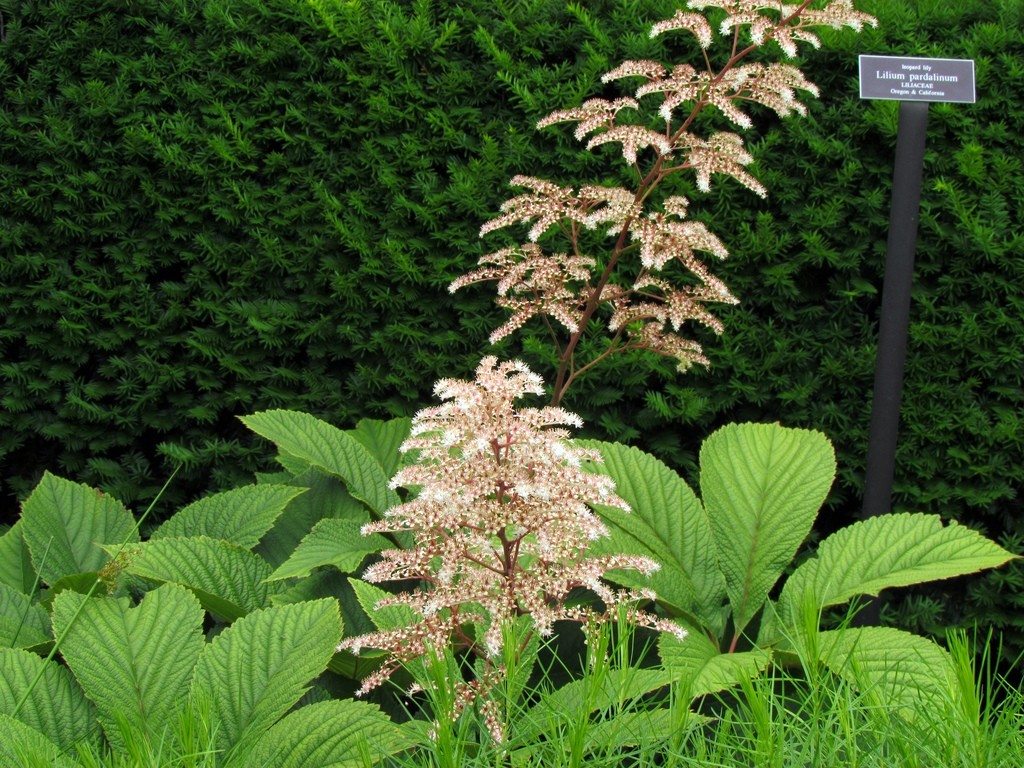Rodgersia Cultivation: Learn About The Care Of Fingerleaf Rodgersia


Fingerleaf Rodgersia plants are a perfect accent for the water or bog garden. The large, deeply lobed leaves spread out and resemble the foliage of the horse chestnut tree. The native range of Rodgersia is China to Tibet. The plant prefers a partial sun environment where soils are moist and slightly acidic. Rodgersia cultivation is a tradition in China where it is used as a natural herbal remedy. This beautiful foliage plant is perfect for an Asian garden.
Fingerleaf Rodgersia Plants
Rodgersia plants are best suited for temperate zones but they are known to be hardy down to USDA plant hardiness zone 3. The foliage provides the majority of the appeal of this plant. Flowers are minimal and resemble an astilbe flower spike. The real selling points are the palmate leaves, which can get up to 12 inches (30 cm.) in width. The deeply veined leaves have five pointed tips, which are favorite snacks of snails and slugs. They unfurl from thick hairy stalks with light mottling. Care of fingerleaf Rodgersia should include slug management to preserve the spectacular foliage. The plant may spread out 3 to 6 feet (0.9 to 1.8 m.) and grows vigorously from rhizomes.
Rodgersia Cultivation
Great foliar shape and form are only a couple of reasons this plant is a must have. The Chinese used it for treatment of arthritis and stomach complaints among other illnesses. It also has antibacterial and antiviral properties. Rodgersia dies back in winter but renews itself in spring. The tiny white to pink flowers arrive in late spring into midsummer. Choose a moist, compost rich soil in semi-shade to partial sun for growing fingerleaf Rodgersia. Perfect locations include around a water feature or in a woodland rainforest garden. Leave plenty of room for the plant to grow and spread.
Care of Fingerleaf Rodgersia
Proper site location will ensure that Rodgersia plant care is minimal. Water the plant when you first install it until it is firmly established. Thereafter, give the plant supplemental moisture when temperatures are hot or dry conditions exist. Trim off dead leaves and stems as needed and remove the flower spike when it is spent. Rodgersia will die back in winter, so remove the spent leaves to make room for new ones in early spring. You can also leave the flowers to produce reddish seed heads for autumn interest.
Propagation of Fingerleaf Rodgersia Plants
Grow more Rodgersia from seed or division. Seeds take several seasons to produce the large showy leaves. Every three years it is desirable to divide your mature plant to promote better growth. Dig it up when dormant in late winter or early spring. Use a clean soil saw or sharp pruners and separate the plant into two pieces. Each piece should have plenty of roots. Replant the pieces in moist but not soggy soil. Follow good Rodgersia plant care and water frequently while the pieces establish. You now have two pieces of a plant that has show stopping foliage and nearly annual appeal.
Sign up for the Gardening Know How newsletter today and receive a free copy of our e-book "How to Grow Delicious Tomatoes".

Bonnie Grant is a professional landscaper with a Certification in Urban Gardening. She has been gardening and writing for 15 years. A former professional chef, she has a passion for edible landscaping.